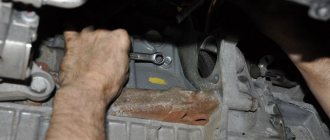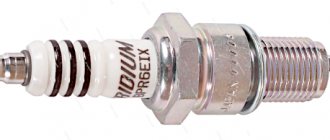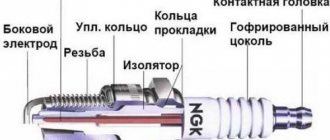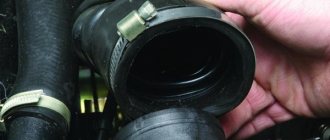This is what the sensor looks like
The mass air flow sensor (MAF) determines the amount of air in the cylinders of a running engine. Using this device, the driver receives information about the engine load. When you press the accelerator pedal, the throttle valve opens, increasing the volume of intake air.
By pressing the gas pedal, you increase the load, and when you take your foot off the pedal, you decrease it. In reality, changing the engine operating mode and vehicle driving conditions does not always allow one to determine the supply of air mass.
Features of the mass air flow sensor
The car can be operated in various conditions, but for good engine operation it requires an optimal combustible mixture enriched with oxygen. The flow meter determines and regulates the amount of air in the engine cylinders. The precise operation of this device allows the car engine to become more powerful.
If the inside of the sensor is cleaned with a rag or cotton wool, it will fail, thereby disrupting the operation of the motor, which will affect all systems of the machine. At a service station, mechanical specialists will not repair the flow meter. If you turn to them for help, you will most likely have to buy and replace this part.
The controller will signal a malfunction of the mass air flow sensor, but an ordinary driver may not be able to recognize the encrypted error code. You have to go to a service station for diagnostics. In fact, a sensor failure is detected only after it is replaced. The life of mass air flow sensors will be extended by routine replacement of the air filter and close attention to seals and piston rings. Oil seals help prevent the gases in the crankcase from becoming oversaturated with oil and the formation of an oil film on the elements. Replacing the air filter is quite easy, even for novice drivers.
Open the hood and find a rectangular box underneath, unscrew the 4 bolts - and you can change the filter. The box shows the location of the corrugations exactly along the arrows.
The sensor is located next to the air filter and determines the amount of air passing through it. The unit contains a sensitive element - a thermistor. At low temperatures its resistance is high, and at higher temperatures it becomes low. There is a fixed value for the moments of increasing or decreasing the temperature - 33°. In the event of a malfunction, the mass air flow sensor generates an error, transfers it to memory, and turns on the device.
Examination
Checking the mass air flow sensor is carried out using a multimeter, diagnostic tool or oscilloscope. In most cases, car enthusiasts do not have equipment that can diagnose sensor failure.
In this case, let's consider checking with a regular multimeter, which almost every driver has or is otherwise inexpensive.
Checking the mass air flow sensor with a multimeter can only be done with a sensor that is installed on an engine without an E-GAS system. The frequency sensor installed in conjunction with the electronic throttle cannot be checked using a multimeter. Checking such a sensor is carried out with a diagnostic device using ADC channels or using a diagram on an oscilloscope.
You can also check the frequency sensor using the ELM327 diagnostic tool; read how to do this in our article.
Verification Process
To check the sensor you will need two needles and a multimeter. The principle of determining the performance of the mass air flow sensor is carried out by measuring the voltage between the contacts.
Checking the circuit
Initially, the sensor's power circuit is checked.
- We switch the multimeter to the DC voltage measuring mode at 20V.
Types and design of sensors
The mass air flow sensor is a complex element of an injection engine. It consists of a sensor module and a tube-shaped housing. On imported air flow devices the grille is metal, while on Russian analogues it is plastic. The dimensions of all sensors are identical; there is a screw for adjusting the carbon dioxide level.
The difference between the sensors is that some of them are touch sensors, others are film ones.
Flow meter designs have changed over the years. In recent years, the most popular in the automotive markets has become the following: a sensor based on a heated wire and a flow meter on a vane damper.
The sensitive element located in the pipe consists of 2 thin platinum threads. When the ignition is turned on, electric current is transmitted to these threads. The current exposes the platinum filaments to heat. The air entering through the air intake cools them and changes the resistance. These signals are monitored by the motor control unit, which increases or decreases air flow.
The positive aspect of this type of sensor is that it quickly responds to changes in air flow, measures the mass of air passed through, and does not interfere with its flow.
This type of flowmeter has a sensing element in the form of a damper in the intake manifold. The resistance is measured by a built-in potentiometer in proportion to the angle of rotation of the damper. Such sensors have a manual setting that helps to lean or enrich the mixture depending on the temperature of the region and time of year. This device restricts air flow, reducing engine power.
There are also modern alternatives: mass flow sensor based on “cold wire” and a membrane flow meter.
In this type of sensor, when air flows pass, self-induction of the sensitive element occurs. It is measured. The basis for the creation of the flow meter was the theory of one of the physicists about vortex shedding. The measurement of the vortex shedding frequency is in accordance with the air flow speed.
The membrane air flow sensor is based on a working membrane placed in the air flow. The control unit evaluates the temperature difference between the sides of the membrane, which are cooled unevenly.
Most often, sensors become unusable due to high mileage of the car or its operation in difficult conditions.
DMRV malfunctions and their consequences
- Sometimes the motor starts to work intermittently;
- The engine runs rough at idle speed;
- the dynamics are disrupted, there is a feeling that it is impossible to accelerate;
- an increase in speed is replaced by a decrease;
- fuel consumption increases.
To know exactly the cause of the MAF malfunction, you need to have a multimeter on hand. Using this device, the air flow sensor on the Priora is tested.
The sensor is located in the pipe
To obtain information about the status of the sensor, you must perform the following actions:
- plug the wires with electrodes into the multimeter, set the voltage to 20 V;
- Place two wires (yellow and green) into the holes of the mass flow sensor and connect the electrodes of the device to them. When you turn on the ignition, the multimeter will take a measurement and display an indicator. We connect the red multimeter probe to the yellow consumable, and the black one to the green one, to ground - this will help measure the voltage between these terminals. The MAF air consumption should be from 0.99 to 1.00. If the device shows large numbers, it means that the Priora sensor is faulty or worn out.
The best injectors for VAZ 2110-12
| The fuel injector is used to atomize fuel; atomization is carried out due to high fuel pressure (several atmospheres). Increased fuel consumption and failures are signs of faulty engine injectors, and which injectors are better to choose? |
Injector malfunctions or how to check injectors: 1. Coking of outlet openings.
- Symptom: increased gas consumption, poor engine starting, deterioration in vehicle dynamics. Otherwise, the engine behaves normally, idle speed is stable and starts normally at positive temperatures; at negative temperatures, starting is difficult.
2. Leaky closing of the nozzle valve.
- Symptom: increased fuel consumption, poor engine starting, tripping or detonation at idle.
- Diagnostics: measure CO (on a normally running engine without a catalyst, CO should not exceed 1% in idle mode. One leaking injector increases CO by approximately 1.0-1.5%).
3. Valve stuck.
- The sign is engine tripping.
- Diagnostics: disconnecting and then connecting the injector electrical connector with the engine running. If the injector is faulty, then there will be no engine response; if the injector is working, then there will be a temporary drop in speed.
4. Unstable valve hanging.
- Symptom: floating idle (a sharp drop in idle speed followed by an increase to 1000 - 1400 revolutions or a complete stop of the engine).
- Diagnostics: as in point No. 3. If one injector hangs unstable, it is guaranteed to be diagnosed as a shutdown. If two or more, then only by replacement.
Example, injectors with a mileage of 198 thousand km.
At 40 thousand km, ultrasonic washing was done, and at 170 thousand km. Lavr decarbonizer was poured. About VAZ injectors of the tenth family: “Dozens” were equipped with Bosch and Siemens injectors. Standard injectors from the factory are mainly Bosch 0 280 158 996 (or 996e) injectors. Interchangeability of VAZ injectors: Injectors are not only of different sizes, but also different in performance. To understand which injectors are suitable for your car, just use the table: Addition to the table: BOSCH 0 280 150 996 injectors are no longer produced, their analogue BOSCH 0 280 158 110 (performance 170 cc/min). There are some differences, for example, the rubber sealing ring on the 110th is a couple of millimeters higher than on the 996th, and the “tail” (from which it splashes) is longer. But there should be no difficulties when installing injectors. Performance of Bosch injectors (taken): Bosch number
Performance
Application
| 0 280 150 001 | 265 cm3/min /3 bars | MB 3.5, Saab 1.7 |
| 0 280 150 002 | 265 cm3/min /3 bars | |
| 0 280 150 003 | 380 cm3/min /3 bars | |
| 0 280 150 007 | 265 cm3/min /3 bars | VW |
| 0 280 150 009 | 265 cm3/min /3 bars | Porsche 914 1.7 |
| 0 280 155 009 | 346 cm3/min/3 bars | Saab Turbo |
| 0 280 150 015 | 380 cm3/min /3 bars | |
| 0 280 150 024 | 380 cm3/min /3 bars | Volvo B30E |
| 0 280 150 026 | 380 cm3/min /3 bars | |
| 0 280 150 035 | 320.6cm3/min/2bars | Jaguar |
| 0 280 150 036 | 380 cm3/min /3 bars | MB 4.5l |
| 0 280 150 041 | 480 cm3/min /3 bars | MB 6.9l V8 / Cadillac |
| 0 280 150 043 | 380 cm3/min /3 bars | BMW |
| 0 280 150 100 | 185 cm3/min /3 bars | |
| 0 280 150 105 | 190 cm3/min /3 bars | Alfa 2.5/3.0, Jaguar XJS, Porsche, Renault, Triumph |
| 0 280 150 114 | 190 cm3/min | VW |
| 0 280 150 116 | 190 cm3/min | VW |
| 0 280 150 121 | 178 cm3/min | Alfa 2.0 Fiat 2.0 |
| 0 280 150 125 | 191.3 cm3/min | Renault, Triumph |
| 0 280 410 144 | 434 cm3/min | Bosch R-SPORT |
| 0 280 410 151 | 244 cm3/min/2 bars | BMW, Jaguar |
| 0 280 410 151 | 308 cm3/min/3 bars | Volvo |
| 0 280 410 152 | 236.5 cm3/min | Alfa Turbo, BMW 2.8, 3.2 |
| 0 280 410 157 | 214.5 cm3/min /2.5 bars | Jaguar 3.6, 4.2 |
| 0 280 150 200 | 300 cm3/min /3 bars | BMW, Peugeot |
| 0 280 150 201 | 236 cm3/min /3 bars | BMW 2.3/3.2/3.5, Chrysler 2.2, Pontiac 1.8, Porsche |
| 0 280 150 203 | 185 cm3/min /2.5 bars | Ford 5.0 |
| 0 280 150 204 | 169 cm3/min /2.5 bars | Volvo 2.1 |
| 0 280 150 205 | 170 cm3/min /2.5 bars | M.B. |
| 0 280 150 206 | 169 cm3/min /2.5 bars | VW 1.9, 2.1 |
| 0 280 150 207 | 108 cm3/min /2.5 bars | |
| 0 280 150 208 | 144cm3/min /2.7 bars | Renault 1.4 |
| 0 280 150 208 | 133 cm3/min /2.5 bars | BMW 323 |
| 0 280 150 209 | 176 cm3/min /2.5 bars | Volvo B200-B230 |
| 169 cm3/min /3 bars | Rover | |
| 0 280 150 210 | 133 cm3/min /2.5 bars | BMW Motorcicle |
| 0 280 150 211 | 146 cm3/min/3 bars | BMW 1.8, Renault 2.2 |
| 0 280 150 213 | 347 cm3/min /3 bars | Ford 1.8, 2.3 |
| 0 280 150 214 | 188 cm3/min/3 bars | |
| 0 280 150 215 | 214 cm3/min /2.5 bars | |
| 0 280 150 216 | 214 cm3/min /2.5 bars | |
| 0 280 150 217 | 169 cm3/min /2.5 bars | Buick 3.8 |
| 0 280 150 218 | 313 cm3/min /3.1 bars | Buick GN |
| 0 280 150 219 | 169 cm3/min /2.5 bars | Ford 2.0 |
| 0 280 150 220 | 148 cm3/min/3 bars | Buick 3.0 |
| 0 280 150 223 | 226 cm3/min /2.48 bars | Vette 5.7 |
| 0 280 150 239 | 226 cm3/min /2.48 bars | Vette 5.7 |
| 0 280 150 335 | 300 cm3/min /3 bars | Volvo B230 turbo |
| 0 280 150 351 | 746 cm3/min /3 bars | Chrysler 2.2 |
| 0 280 150 355 | 389 cm3/min | Volvo |
| 0 280 150 355 | 300.6 cm3/min /3 bars | Volvo |
| 0 280 150 400 | 437 cm3/min/3 bars | Ford 4.5l |
| 0 280 150 401 | 437 cm3/min/3 bars | Ford |
| 0 280 150 402 | 338 cm3/min/3 bars | Ford |
| 0 280 150 403 | 503 cm3/min/3 bars | Ford |
| 0 280 150 415 | 190 cm3/min /3.5 bars | BMW |
| 0 280 150 422 | 264 cm3/min /2.7 bars | |
| 0 280 150 440 | 250 cm3/min /2.5 bars | BMW |
| 0 280 150 601 | 503 cm3/min /2.5 bars | Ford |
| 0 280 150 608 | 437 cm3/min /2.5 bars | Ford |
| 0 280 150 614 | 189 cm3/min/3 bars | Renault |
| 0 280 150 702 | 189 cm3/min/3 bars | Alfa 3.0 |
| 0 280 150 703 | 149 cm3/min/3 bars | Rover 1.4 |
| 0 280 150 704 | 170 cm3/min /3 bars | |
| 0 280 150 706 | 214 cm3/min /2.5 bars | 250kPa |
| 0 180 150 711 | 192 cm3/min /2.5 bars | |
| 0 180 150 712 | 214 cm3/min /2.5 bars | 250kPa Saab Turbo 2.3l |
| 0 280 150 715 | 149 cm3/min/3 bars | BMW 1.8, 2.5, 5.0 |
| 0 280 150 716 | 134 cm3/min/3 bars | BMW 2.7 |
| 0 280 150 718 | 199 cm3/min /2.2 bars | Ford/Trucks 5.0 |
| 0 280 150 725 | 172 cm3/min /2.5 bars | GM 2.0, Volvo 2.3 |
| 0 280 150 727 | 147 cm3/min /2.3 bars | Ford/Trucks 5.0, 4.9 |
| 0 280 150 728 | 252 cm3/min /2.96 bars | Saab Turbo |
| 0 280 150 734 | 203 cm3/min /2.5 bars | Peugeot 1.9, 2.2, 2.8, Volvo |
| 0 280 150 744 | 214 cm3/min /2.5 bars | GM 2.0 |
| 0 280 150 756 | 326 cm3/min/3 bars | GM 4.3 Turbo |
| 336 cm3/min /3.1 bars | GM 4.3 Turbo | |
| 0 280 150 759 | 229 cm3/min /2.7 bars | Ford 460 Trucks |
| 0 280 150 762 | 214 cm3/min/3 bars | Volvo B230F |
| 0 280 150 775 | 199 cm3/min /3.3 bars | |
| 0 280 150 802 | 284 cm3/min / 3 bars | Volvo B200 turbo, Renault J7R turbo |
| 271 cm3/min / 2.5 bars | Volvo | |
| 0 280 150 803 | 384 cm3/min / 2.7 bars | Porsche |
| 0 280 150 804 | 337 cm3/min / 3 bars | Peugeot 505T |
| 0 280 150 808 | 337 cm3/min / 3.8 bars | Mazda, Chrysler 2.2 |
| 0 180 150 811 | 298 cm3/min / 3.5 bars | 3.5kPa Porsche Turbo 944 |
| 0 280 150 814 | 384 cm3/min / 3 bars | |
| 0 280 150 834 | 397 cm3/min / 3 bars | Chrysler |
| 0 280 150 835 | 397 cm3/min / 3 bars | Chrysler |
| 0 280 150 901 | 197.6 cm3/min / 3 bars | GM 3.8, 5.0 |
| 0 280 150 902 | 197.1 cm3/min | Audi 4-2.0l, VW 4-1.8l |
| 0 280 150 903 | 197.1 cm3/min | VW 1.8l |
| 0 280 150 905 | 244.9 cm3/min | VW 1.8l |
| 0 280 150 911 | 315 cm3/min / 2.7 bars | Ford 3.8 Supercharge |
| 0 280 150 912 | 326 cm3/min / 3 bars | Ford 3.8 Supercharge |
| 0 280 150 913 | 255 cm3/min / 2.7 bars | |
| 0 280 150 945 | 300 cm3/min | Ford |
| 0 280 150 947 | 256 cm3/min / 2.7 bars | Ford |
| 0 180 150 951 | 346 cm3/min / 3 bars | Porsche Turbo |
| 0 280 150 967 | 378 cm3/min / 3 bars | Ford 3.8 Supercharge |
| 0 280 155 009 | 346 cm3/min / 2.7 bars | Saab Turbo |
| 0 280 411 911 | 841 cm3/min / 3 bars | |
| 0 280 410 153 | 608.5 cm3/min /2.5 bars | |
| 811.4 cm3/min / 5 bars | ||
| 0 280 412 911 | 811.4 cm3/min /2.5 bars | |
| 1146 cm3/min / 5 bars |
How to replace injectors on a VAZ 2110: Instructions for removing and installing injectors are in the article cleaning injectors. Partial replacement is allowed. Repair of injectors: Flushing the injectors is effective after a mileage of about 40 thousand. km. If you decide to replace the injectors with your own hands, then in terms of cost it is better to immediately replace them with new ones. Price of injectors: Price from 600 to 1000 rubles. Where to buy injectors: For example, in online stores (section “Spare parts”). So, vote and leave reviews of injectors for VAZ tenth family:
- What injectors were installed and how long they lasted:
- Which injectors were replaced?
ps Off-topic comments will be deleted.
xn--2111-43da1a8c.xn--p1ai
Possibility of visual inspection of the device
Checking the sensor operation
The air meter corrugation clamp must be unscrewed with a curly screwdriver, removed and carefully inspected the internal walls of the sensor parts. The insides should be free of condensation and oil stains, the surfaces should be dry and clean. The most common cause of failure of the air flow sensor is dirt getting inside.
Carburetor cleaner is suitable for cleaning. Using a spray bottle, we spray the cleaner onto small wires - sensitive sensors that are attached inside with a special resin. This must be done very carefully so as not to damage the film and the sensors themselves. We wait for the sprayer to dry and carry out the procedure several more times, taking into account the degree of contamination of the device. You can also wash the element with alcohol. These actions can extend the life of the flow meter and reduce the cost of purchasing spare parts for the machine.
Another way is to unscrew the sensor with a key and remove it from the air filter. Pay attention to the location of the seal. It does not allow the suction of unfiltered air into the inlet passage of the converter. Sometimes this ring gets stuck in the filter and takes the wrong position, then you can see dust on the filter mesh. This is one of the reasons why the flow meter fails. Installation is carried out in the reverse order: put the seal on the sensor, insert the device into the air filter housing.
There is a third option for monitoring the air flow sensor - ask friends for help. Take a flow meter in good condition, put it in place in your Priora car and compare the results of your own and newly installed devices. If there are differences, the mass air flow sensor must be replaced.
You can replace the sensor yourself by turning off the electric ignition and disconnecting the converter connector. Remove the clamps of the Priora meter, the hose of the air intake pipe connected to the air filter housing, then the sensor itself and replace it with a new one.
With proper care, the reliability of the sensor ensures its longevity. A significant influence on the durability and reliability of the device is exerted not only by the quality of the installed parts, but also by the operating conditions.
The MAF, or mass air flow sensor, is needed to determine the amount of air in the car. While the engine is running, this air fills the cylinders.
What happens with reduced or increased air flow?
You should definitely know that air affects not only the amount of fuel burned in the engine, but also the dynamic characteristics of the car. Therefore, deviations from the above standard indicators lead to the following consequences:
- if there is less air than needed, fuel is consumed more slowly. However, at the same time, dynamic characteristics decrease and engine power decreases;
- With increasing consumption, the dynamics increase, but the fuel burns much faster.
In addition, if the deviation is 2-4 kilograms from the norm in any direction, then the power unit may go into emergency mode and begin to work incorrectly.
Overview and characteristics of the mass air flow sensor
The sensor is connected to the electrical harness and is located in the intake tract. The signal from the mass air flow sensor is a direct current, which has its own voltage. The magnitude of the current depends on the movement of air in the Priora that has passed through the sensor. The Priora mass air flow sensor includes:
Components
thermoelement. The first determines the temperature in the environment. Heating the air to the desired specific temperature is assigned to the next two thermoelements.
During the measurement of electrical power, the determination of the consumed air begins to occur. Electric power maintains the temperature at the desired level.
The filter that is installed in the Priora mass air flow sensor prevents large particles from entering the sensor housing. If this happens, the thermocouples may fail. It also has the function of cutting air to ensure even distribution of air. The filter is fixed with a ring intended for it in the inlet flange.
There is one rubber ring on each side of the housing for sealing. This is done to prevent air from being sucked in. Great importance should be paid to the seal ring located between the housing and the outlet flange located in the sensor. If air begins to be sucked in, the system will not be able to take this into account, as a result of which the fuel mixture will become leaner. In this case, it is impossible to ensure maximum engine performance. It will be difficult to know that this is the problem with poor sensor performance. This will be difficult to do even with measuring instruments.
To remove the mass air flow sensor, turn off the ignition and then disconnect the sensor from the connector. Disconnect the air hose connected to it. Then, unscrew a couple of bolts and disconnect it from the air filter. You need to put the mass air flow sensor in place in the reverse order.
If foreign particles get into the mass flow sensor housing, it may fail. The MAF is a precise measuring device and, as has already been proven, does not tolerate anything hitting its body. The sensor on the car can be wire or film.
What air flow should be on the Lada Priora: technical specifications
Domestic VAZ 2170 Priora cars are equipped with two versions of gasoline 4-cylinder engines: the 8-valve VAZ 21116 and the 16-valve powerful VAZ 21126, developed on the basis of the VAZ 2112 engine. 16 valves in the engine design with the same cylinder displacement increase the power of the power unit in comparison with 8-valve option. The injection engine of the Lada Priora is equipped with an exhaust gas catalytic converter, combined with an exhaust manifold in one housing, and a fuel injection distribution mechanism.
Lada Priora has been produced by the domestic concern AvtoVAZ since 2007. This is one of the mass-produced budget small-class cars that replaced the Lada 2110.
The production of Priora will be discontinued at the end of 2016 due to the launch of a more modern Lada Vesta model.
Compared to the engines of previous Lada models, the new Priora power units with 16 valves have become 10.5% more powerful, and also received an additional service life of 50 thousand km and a lightweight connecting rod and piston group.
Determining the malfunction of the mass air flow sensor
There are various breakdowns in the Priora mass air flow sensor. To understand that the mass air flow sensor is faulty, you need to check it using the Check Engine lamp, or a multitester designed for testing. If you are shown error codes 34 or 33, then the mass air flow sensor has a malfunction. This means you need to check the motor. Another evidence of a malfunction of your mass air flow sensor in Priora is an increase in fuel consumption. If your engine does not start well, this may also indicate a problem with the mass air flow sensor.
If you notice poor acceleration dynamics, the car begins to brake sharply and accelerate sharply, then this also serves as a signal that your sensor is broken. Interruptions in engine operation and jumps in speed also indicate this. If the car stops the engine when changing gears, then you should check the sensor.
The engine crankcase ventilation system has its own characteristics. It has two circuits installed. The first one is large, it starts working when the throttle valve is open. The second is small, works in idle mode, when the throttle is closed. During operation with the throttle closed, crankcase gases enter the throttle space.
And some of them touch the film resistor of the mass flow sensor. The deposited resins begin to change the characteristics of this resistor, so the sensor begins to fake. In this regard, the idle speed controller also begins to malfunction, this affects the engine starting. The mass air flow sensor becomes faulty. A common problem with the sensor is contamination of the coil. They can be cleaned using carburetor cleaner, but this must be done carefully.
Lada Priora: official and real data on fuel consumption
The VAZ company presented the Lada Priora as a deep modernization of the 2110 model in 2007. This car was immediately noticed on the domestic market due to its suitable performance characteristics, practical sedan, hatchback and station wagon bodies, reliability of engines, chassis and transmission. In 2014, the model was restyled, its appearance changed, and an option with a robotic gearbox appeared. At the same time, Lada Priora shows economical fuel consumption in each of the trim levels, which added to its popularity.
Engines and official fuel consumption rates for Lada Priora
Popular among domestic car enthusiasts, the Lada Priora is equipped with a line of gasoline engines developed by the VAZ concern. They have proven themselves to be reliable and maintainable units. The following motors are installed on the car:
- 1.6 at 90 forces:
- 1.6 at 98 forces;
- 1.6 at 106 forces;
- 1.8 at 123 or 130 forces.
An important feature is that the fuel consumption of the Lada Priora does not exceed that of the leaders of its class. Given the relative cheapness of the car, this attracts additional attention from potential buyers. Priora has mechanical and, since 2014, automatic transmissions.
First generation
In the basic configuration, the Lada Priora in sedan, hatchback and station wagon bodies was equipped with a 1.6 petrol engine with eight valves producing 90 horsepower.
With it, the car accelerates to 176 km/h, and to the first hundred in 13 seconds. The fuel consumption of this modification of the Lada Priora, with a five-speed manual transmission, is 8.8 liters of AI 95 gasoline in the city.
On the highway this figure is 6.2 liters per 100 kilometers, the average is 7.2 liters.
Equipped with an engine of the same volume, but with 16 valves, Priora received an additional 8 horsepower, which had a positive effect on the maximum speed, which was 183 km/h, and the car reached the first hundred in 11.5 seconds. Gasoline consumption in traffic increased and amounted to 9.8 liters, but on the highway it decreased to 5.6. Consumption in mixed mode did not change significantly.
By 2013, it was decided to modernize the 1.6 liter sixteen-valve engine. After modification, its power increased to 106 forces. With the same dynamic characteristics, this resulted in a reduction in fuel consumption in the city to 8.8 liters; on the free road, the consumption rate decreased to 5.5 liters per hundred, the average value was 6.4 liters.
Restyling
In 2014, it was decided to restyle the model, the appearance of which became more modern and dynamic. The Priora was equipped with the same 1.6 liter power units, but with an automatic transmission developed by VAZ specialists. They managed to maintain the dynamic characteristics of the car and maintain the same gas mileage as versions with manual transmission.
In the same year, Priora began to be produced, which installed 1.8 gasoline engines with 16 valves for 123 and 130 horsepower. This made it possible to increase the speed to 190 km/h, and the acceleration dynamics to 10 seconds. On a busy road it consumes 9.8 liters of gasoline, and on the highway 5.4 liters of gasoline.
Excessive fuel consumption - popular reasons
As in any other car, the fuel consumption of the Lada Priora can differ significantly from the passport one. In most cases, this is accompanied by “diseases” of this car associated with the electronic engine control unit:
- failure of the temperature sensor in the cylinder block;
- failure of the lambda probe (oxygen supply sensor);
- deterioration of the idle speed regulator in the throttle assembly;
- failure of the sensor that controls air consumption.
When replacing these sensors, it is necessary to install only parts approved by the manufacturer, since this also plays a significant role and can cause an increase in fuel consumption.
Fuel consumption also increases if there are problems with the fuel system - clogged injectors, untimely replacement of filters, clogged catalyst. If the thermostat fails, the engine takes a long time to reach operating temperature, which also leads to excessive fuel consumption.
Another reason for overspending is a dynamic driving style. Experience shows that in order to save fuel, you should not exceed the speed limit even on an uncrowded road with a good surface; this will still lead to a sudden increase in consumption.
Reviews from Lada Priora owners
Opinions of Lada Priora owners differ on the fuel consumption of engines of various modifications. Most of them say that, in general, this car shows results consistent with the passport data. In many ways, actual gasoline consumption is adjusted by the condition of the car and driving style.
Eight-valve engine 1.6
- Valery, Nizhny Novgorod. I considered different versions of the VAZ - Kalina, Largus, but settled on a Priora with a 90 horsepower engine. It seemed to me a good price-quality ratio. The car is pretty good, especially for our roads, the consumption in a circle is about 8 liters per hundred, I’m satisfied with that.
- Anatoly, Klin. I took the car in 2010 from the showroom, the 1.6 engine for 90 horses is enough, the ride is reliable, about 9 liters are consumed per 100 km with a manual transmission, on the highway it drops to 6. At the same time, I use AI 92, although it is of high quality. I really like the look and have no plans to change it yet.
- Alexey, Volgograd. I bought my Priora back in 2008, since then it has served me faithfully. The 90 hp engine, in my opinion, is rather weak, the stiffness of the suspension is justified by the quality of our roads. The only complaint is that the cabin is a little cramped, but we have to put up with it. As for consumption, it is quite adequate, in mixed mode up to 8 liters, in winter up to 9.
Sixteen-valve engine 1.6 98 hp
- Peter, Energodar. I drove a VAZ G8 for a long time, but in 2010 I switched from it to a Priora and immediately felt the difference. Comfortable interior, no noise when driving, satisfactory build quality. The disadvantages include difficulties when changing gears, the third one is especially difficult to engage. But the consumption is pleasing, depending on the season, 7.5-8.5 liters, which is still needed for happiness...
- Oleg, St. Petersburg. After tuning the Priora’s engine and switching to 16 valves, I decided to take this particular car. I must note that not everything about it suits me, the first breakdown at 10 thousand is the heating system, the lack of air conditioning in my configuration is depressing. Gasoline consumption is about 7 liters per hundred.
- Vladimir, Novosibirsk. I am a new driver, so I decided to buy a used Priora 2012, I liked the car in many ways, although it is noisy. The rigid suspension shakes a lot when driving onto a dirt road, but it is quite reliable. Consumption in city mode is up to 10 liters, on the highway no more than 7.
How to repair a Priora mass air flow sensor?
The MAF costs a lot. According to the laws of the market, there are reasons for this. However, everything is much simpler! We have to pay a high price for the sensor due to our ignorance. Few people imagine how the mass air flow sensor works. Also, few people know why it stops working. Sellers always impose the opinion that if the mass air flow sensor starts to mope, then you definitely need to buy a new one.
The structure of the sensor is simple. But if you cannot find the fault in its malfunction, then it is better to visit a car repair shop. It is difficult to overestimate the role of the sensor. In order for the controller to monitor the uninterrupted operation of the ignition and injectors, it must more accurately know the air flow of the engine. The engine may lose power, increase fuel consumption, and worsen acceleration dynamics just because the mass air flow sensor has begun to produce inaccurate data.
When repairing a Priora, the mass air flow sensor should be checked with a diagnostic device, the scale of which is up to 2 V. The wire from the device is inserted between the rubber seal and the yellow wire. Do this until the contacts rest. Measure the voltage at this contact point. To do this, turn the ignition key. The ideal option is 0.99 V. When measuring, inaccuracy is allowed, but not more than 1.03 V. If the readings are higher, someone immediately runs to the store to buy a new sensor. But let's not rush.
Using pliers, unscrew the screws that secure the measuring element to the sensor. It is better to select self-tapping screws for a Phillips screwdriver. It will be easier for you to unscrew them in the future. Now you need to work with the removed element. Prepare washing equipment in advance. This will be an aerosol carburetor cleaner. Bend its tube at an angle of 90˚.
To do this, heat the tube in the flame of a match. After this, cut it so that the tube itself is straight and the stream is directed to the side. Insert it into the upper valve of the removed element by 10 mm and rinse the resistor. Repeat this procedure after a couple of seconds. Remember that the resistor cannot withstand any force. Forget about brushes, cotton swabs and compressed air.
If it is impossible to check the mass air flow sensor with a special device for diagnosing the air flow sensor, then you can resort to using a standard voltmeter. It will ensure the accuracy of your measurements. Take measurements between ground (most often this is the green wire) and the mass air flow sensor input (here most often this is the yellow wire).
Allow the cleaner to dry. Only then insert the sensor back into the housing. After this, the voltage measurement should be repeated. If during the measurement everything remained the same, then the mass air flow sensor on the Priora really did its job.
Reduce fuel consumption - ways that really work for car enthusiasts
To summarize, in order not to overpay for fuel that burns inefficiently, you should monitor the technical condition of the car and learn how to drive it economically. To the not entirely successful build quality, disgusting design and poor driving characteristics in its class, which have already become the hallmark of the Lada, new nuances have been added.











